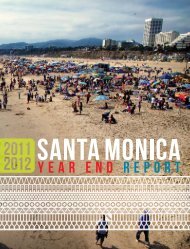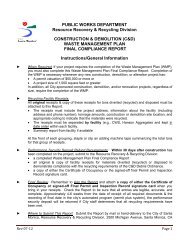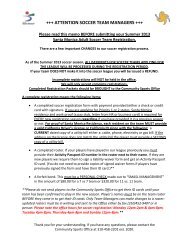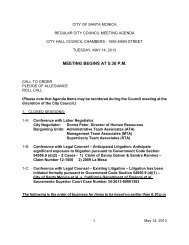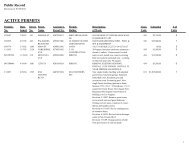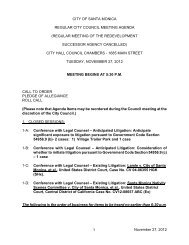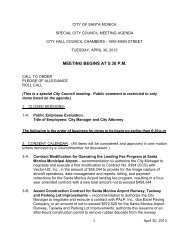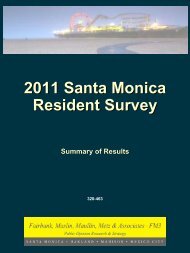Comprehensive Annual Financial Report - City of Santa Monica
Comprehensive Annual Financial Report - City of Santa Monica
Comprehensive Annual Financial Report - City of Santa Monica
Create successful ePaper yourself
Turn your PDF publications into a flip-book with our unique Google optimized e-Paper software.
Cash Management Policies and Practices. The <strong>City</strong>’s Investment Policy (Policy) sets broad legal<br />
guidelines which govern the investment <strong>of</strong> cash balances. The Policy, established in accordance with State<br />
law, has been certified by the Association <strong>of</strong> Public Treasurers, United States and Canada. The Policy is<br />
reviewed annually and approved by the <strong>City</strong> Council. The primary objectives <strong>of</strong> all <strong>City</strong> investments, in<br />
priority order, are safety and preservation <strong>of</strong> principal, liquidity to meet cash flow needs, and a market rate <strong>of</strong><br />
return after the first two objectives have been met. Within this framework, the <strong>City</strong> has developed an<br />
Investment Plan (Plan) which guides strategy and structure <strong>of</strong> the portfolio. The Plan sets targets for the<br />
portfolio by investment type as well as benchmarks to measure return.<br />
Debt Administration. At June 30, 2009, the <strong>City</strong>'s general obligation bond rating was the highest possible<br />
with an Aaa from Moody’s; AAA from Fitch; and AAA from Standard and Poor’s. All other <strong>City</strong><br />
indebtedness is considered to be at least investment grade. The <strong>City</strong>’s bonded debt applicable to its debt limit<br />
consisted <strong>of</strong>: $18.5 million <strong>of</strong> Main Library Improvements Project General Obligation Bonds; $23.1 million<br />
in Public Safety Facility Lease Revenue Bonds; $37.3 million in Civic Center Parking Structure Bonds; $72.9<br />
million in Earthquake Recovery Redevelopment Project Tax Allocation Bonds and Ocean Park<br />
Redevelopment Projects Tax Allocation Refunding Bonds; and $7.5 million in Parking Authority Lease<br />
Revenue Bonds. A calculation <strong>of</strong> the <strong>City</strong>'s debt limit is detailed in Table 14 <strong>of</strong> the Statistical Section <strong>of</strong> this<br />
CAFR.<br />
The <strong>City</strong> has other long-term payment obligations, which are not bonded debt, e.g., claims payable. These are<br />
detailed in Note 9 in the notes to the basic financial statements.<br />
Risk Management. The <strong>City</strong> established a Risk Management program in 1986 to minimize the exposure <strong>of</strong><br />
the <strong>City</strong>’s assets and resources (both human and financial) to accidental loss. The program is staffed by a<br />
full-time Risk Manager and includes risk identification and evaluation, risk control, risk transfer, and risk<br />
financing. Services include administration <strong>of</strong> claims filed by the public and employees and safety training<br />
and loss prevention.<br />
Additional information about the <strong>City</strong>’s risk management practices can be found in Note 15 <strong>of</strong> the notes to the<br />
basic financial statements.<br />
Pension and Other Postemployment Benefits (OPEB). The <strong>City</strong> contributes to the California Public<br />
Employees’ Retirement System (CalPERS), an agent multiple-employer public employee defined benefit<br />
pension plan. CalPERS provides retirement and disability benefits, annual cost-<strong>of</strong>-living adjustments and<br />
death benefits to plan members and beneficiaries. CalPERS acts as a common investment and administrative<br />
agent for participating public entities within the state <strong>of</strong> California. Benefit provision and all other<br />
requirements are established by the State statute. The amount <strong>of</strong> the <strong>City</strong>’s required annual contribution is<br />
determined actuarially. It is the policy <strong>of</strong> the <strong>City</strong> to fully fund the annual required contribution to ensure that<br />
the plan will be able to fully meet its obligation to retired employees.<br />
In addition, in accordance with agreements with various bargaining units, the <strong>City</strong> provides other<br />
postemployment benefits to retirees. Funded on a pay-as-you-go-basis, a net OPEB obligation <strong>of</strong> $2.4 million<br />
is reflected in the Statement <strong>of</strong> Net Assets as <strong>of</strong> June 30, 2009.<br />
In addition to the CalPERS pension benefits and other postemployment benefits to retirees described above,<br />
the <strong>City</strong> contributes to postemployment medical premium reimbursement plans for employees. These plans<br />
were established by employees to mitigate the impacts <strong>of</strong> postemployment medical costs and are managed by<br />
trustees from the various employee groups.<br />
Additional information regarding the <strong>City</strong>'s pension benefits and other postemployment benefits can be found<br />
xi





